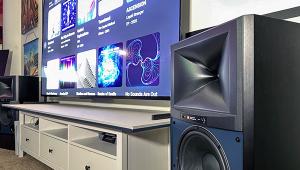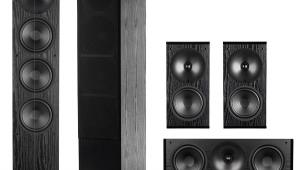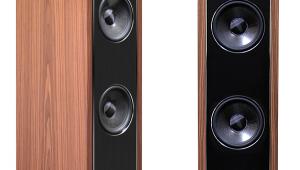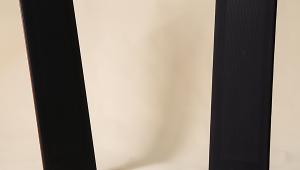Epos M22 Speaker System and Butler Audio TDB 5150 Amplifier
There's a compelling magic that has kept my butt on the sofa— it's the enthralling And Starring Pancho Villa as Himself. It was for no small reason that this HBO film earned an Emmy for sound editing. The width and depth of the soundscape, the detailed sound bits, the way the dialogue comes through, and the score's ability to underscore the power and poignancy of scene after scene are remarkable. Each of these turns a made-for-TV movie into a film that transcends the limitations of the home venue for which it was created. And the system I've been using—an Epos M Series 5.1 speaker setup powered by the Butler Audio TDB 5150 vacuum-tube power amplifier—reveals such wonderful nuances in Pancho Villa that I have been completely glued to the couch.

From Two-Channel to Five and Beyond. . .
Founded in 1983, Epos quickly established itself as a sophisticated British performer with a solid musical reputation. Eventually, however, changing tastes, the costs of production, promotion, and shipping—as well as the two-channel crowd's fickle taste over the years—caused the company's fortunes to sour. Then, in 1999, Michael Creek purchased the brand. He knew a few things about quality, mass production, and resilient and accessible price points. Over the next few years, under Creek's oversight, Epos launched the M Series speaker line, but not initially as a 5.1 system. Acclaim followed the revivified Epos, at which point Creek upped the ante by moving into home theater. By 2005, with the introduction of the ELS SUB subwoofer, an entire 5.1 line with various possible options came into existence. The setup I've tested represents Epos' top-of-the-line configuration—and, at $3,945, it's a lot of speaker for the money.
Don't be fooled by the size of the Epos M22 tower speakers, which are relatively modest in comparison to other price-point equivalents. Though only 36 by 8 by 10 inches, each wood-veneered MDF-embraced tower houses a 6-inch poly woofer, a 6-inch poly midrange driver, and a 1-inch gold-anodized aluminum-alloy dome tweeter. (All of the speakers in the system use the same tweeter, which the company calls the Nightingale.) Using a design said to minimize diffraction effects, the 1-inch-thick MDF cabinet readily passes the knuckle test, thanks in part to extensive particle-board bracing. The cabinet sounds solid and inert, especially its lower half, which is an internally separate enclosure that houses the bass driver.
The bass driver comes complete with a 32-millimeter voice coil and an injection-molded dust cap, while its enclosure ports near the cabinet's bottom. The lower octaves show control and a tightness that belies the specified extension to 38 hertz. The upper portion of the M22 houses the midrange driver and a Ferrofluid-cooled tweeter, which incorporates a neodymium magnet system. The midrange driver's rigid die-cast aluminum chassis is rear-vented, and the company says that this reduces voice-coil temperatures, thus minimizing compression, especially during ultradynamic passages. The M22 floorstander is tri-wirable. (Jumpers are included.)
A sonic match for the M2, the M8 center channel has two 5.25-inch midbass drivers flanking one tweeter. Epos has isolated each midbass driver in its own sealed subenclosure. They note that they have adjusted the low-frequency extreme of one of the midbass drivers by coupling it with a capacitor. This is to avoid the cancellation that can occur when two closely spaced drivers with the same frequency response run in parallel. Although the M8 is akin to a two-way design, the crossover modification allows the center channel to function, according to Epos, as if it were more like a three-way speaker. Epos cautions that this approach to driver integration in the M8 will move the center image from the tweeter to midway between the tweeter and one of its woofers. The image shift is about 2.25 inches and is virtually unnoticeable. The drivers are anchored onto a 1-inch-thick wood-veneered MDF baffle, while the rest of the speaker cabinet sports a thickness of slightly more than 0.5 inches of MDF. As with the M22, the bottom-end frequency response seems significantly lower than the specified 60 Hz.
The M5, for practical purposes, is a two-way bass-reflex minimonitor that uses the same Nightingale tweeter as all of the other M Series speakers. The midbass driver, again the 5.25-inch design found in the M8 center channel, has a claimed frequency response down to 60 Hz. The cabinet has a similar thickness to that of the center channel and, like it, passes the knuckle-rap test.
Finally, the ELS SUB subwoofer completes the system. Housed in a sealed box, the sub's 10-inch driver is a front-firing affair. Epos claims they have avoided the use of a vent in an effort to eliminate what they call "chuffing air turbulence." The ELS SUB certainly plays tightly and does admirably well in the lowest octaves, with no noticeable overhang. It provides more than enough foundation for CDs (it's rated down to 20 Hz), but I was left wondering how much more impactful the low-frequency effects could have been for films with two subwoofers in place. Don't get me wrong: This 300-watt-rated, self-powered animal is a no-brainer, especially for the medium-to-small rooms for which Epos designed the M Series. But oomph is oomph. The ELS SUB has circuitry that shuts down the signal when it senses an overcurrent or high-temperature condition.
Tube and Solid-State Sound in One Heavy Package
Let me say this up front: I want to own the Butler Audio TDB 5150, but not because I'm a dyed-in-the-wool tubeoholic (which I am, and that's my bias). This amplifier uses one twin-triode tube (6SL7GT) per channel. Engineer B.K. Butler has designed vacuum-tube-related gear for the likes of Billy Gibbons of ZZ Top, Eric Clapton, Elton John, and David Gilmour of Pink Floyd. The TDB 5150 operates in the zero-global-negative-feedback zone, and the solid-state output stages run without output transformers. The amp even has multiple safety features. Perhaps the above sways me just a bit, but the biggest reason I like the TDB 5150 is that it exemplifies the aspects I like best about both vacuum-tube and solid-state circuits done right. It presents harmonically rich musical structures and allows the listener to perceive a sense of depth, whether you listen to stereo-based music or film scores. It grips bass drivers like a solid-state product and soars with delicacy into the upper frequencies without sounding hard. This is an amplifier that serves both music and film-sound needs spectacularly.





























































